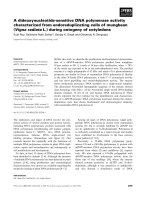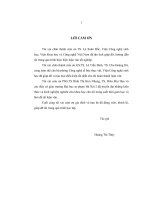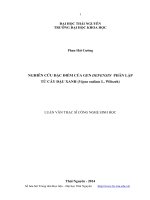Nutrient management in mungbean [Vigna radiata (L.) Wilczek] for higher production and productivity under semi-arid tract of Central India
Bạn đang xem bản rút gọn của tài liệu. Xem và tải ngay bản đầy đủ của tài liệu tại đây (152.42 KB, 6 trang )
Int.J.Curr.Microbiol.App.Sci (2017) 6(7): 488-493
International Journal of Current Microbiology and Applied Sciences
ISSN: 2319-7706 Volume 6 Number 7 (2017) pp. 488-493
Journal homepage:
Original Research Article
/>
Nutrient Management in Mungbean [Vigna radiata (L.) Wilczek] for Higher
Production and Productivity under Semi-arid Tract of Central India
Ghanshyam Verma1, Narendra Kumawat2* and Jagdeesh Morya3
1
Department of Seed Technology, Institute of Agricultural Sciences,
Bundelkhand University, Jhansi (U.P.), India
2
AICRP on Maize, Zonal Agricultural Research Station, Jhabua – 457 661 (M.P.), India
3
Krishi Vigyan Kendra, Jhabua – 457 661 (M.P.), India
*Corresponding author
ABSTRACT
Keywords
Nutrient
management,
Mungbean and
Semi-arid.
Article Info
Accepted:
04 June 2017
Available Online:
10ss July 2017
A field experiment was carried out during kharif 2013-14 at Agriculture Research Farm,
Institute of Agricultural Sciences, Bundelkhand University, Jhansi, Uttar Pradesh to study
the effect of nutrition management on growth, yield attributes and yields of mungbean.
Results reveals that application of Rhizobium + PSB + 20 kg N/ha gave significantly
higher number of nodules (25.10/plant) and dry weight of nodules (24.10 mg/plant) which
was statistically at par with Rhizobium + PSB + 60 kg P2O5/ha. Similarly maximum yield
attributes viz., number of pods (70.48), pod length (5.78), number of seeds (8.68) and test
weight (40.05 g) were recorded with the application of Rhizobium + PSB + 60 kg P2O5/ha.
Further results showed that highest grain yield (1235 kg/ha), straw yield (2507 kg/ha),
harvest index (33.0%) and production efficiency (17.39 kg/ha/day) were also recorded
under Rhizobium + PSB + 60 kg P2O5/ha. Therefore, it is suggested that for achieving
sustainable higher production and productivity of mungbean should be fertilized with
Rhizobium + PSB + 60 kg P2O5/ha.
Introduction
Mungbean (Vigna radiata L.) is widely
cultivated throughout southern Asia including
India, Pakistan, Bangladesh, Sri Lanka,
Thailand, Laos Taiwan south china and
Malaysia in India, mungbean is cultivated in
all the three seasons, that is kharif, rabi and
zaid. It is one of the important pulse crops
cultivated in India ranking third having about
70% of the world area and 45% of production.
Mungbean is mostly grown in the state of
Rajasthan (30.81%), Maharashtra (19.51%),
Karnataka (15.35%), Andhra Pradesh
(12.79%), Orissa (7.41%), Tamil Nadu
(4.97%), and Uttar Pradesh (2.09%). In India
area occupied by mungbean is about 3.0 m ha
with total production of 1.1 million tones but
average productivity is 3.20 (q/ha). It is one
of the worth of crops rich in protein.
Mungbean seeds are rich in protein that is
used completed, split peas or flour. Compare
with the varieties mungbean very easily
digestible, palatable and tastier. Its seed for
produce soup, seasoned rice is used. During
summer, it can also be used as a green manure
crop. Being a leguminous crop, it has the
capacity to fix atmospheric nitrogen. Its green
plants are used as fodder after removing the
mature pods (Kumawat et al., 2009b). The
488
Int.J.Curr.Microbiol.App.Sci (2017) 6(7): 488-493
yield and nutrition quality of pulses is greatly
influenced by application of nutrient
elements, organic manures and biofertilizers
(Kumawat et al., 2010). The association of
Rhizobium and pulse plants helps in
improving fertility of soil and is a cost
effective method of nitrogen fertilization in
legumes (Meena et al., 2014). The amount of
nitrogen fixed varies with the strain of
Rhizobium,
the
plant
species
and
environmental conditions. Because of
nitrogen fixation legumes are self-dependent
for their N requirement and play a significant
role in maintaining the nitrogen balance in the
soil. They also improve both physical
properties such as soil aggregate stability,
bulk density and biological properties of soil
(Bahadur and Tiwari, 2014).
Bundelkhand University, Jhansi, Uttar
Pradesh, which is geographically located at
250.27” N latitude and 780.35 E longitude at
an altitude of 271 meters above the mean sea
level in semi-arid tract of central India. The
soil was sandy loam in texture, neutral in
reaction (pH 7.4), low in organic carbon
(0.48%), low available nitrogen (212.0 kg/ha),
medium available phosphorus (14.0 kg
P2O5/ha) and medium in potassium (185.0 kg
K2O/ha) content. The experiment was laid out
in randomized complete block design with
three replications. The experiment comprised
of the eight treatment combinations i.e.
control, Rhizobium, PSB, Rhizobium + PSB,
Rhizobium + 20 N/ha, PSB + 60 P2O5/ha,
Rhizobium + PSB + 20 N/ha and Rhizobium +
PSB + 60 P2O5/ha.
Application of nitrogen in combination with
phosphorus to mungbean also increases its
yield and yield components while nitrogen
uptake and protein content of mungbean
increase with increasing rate of applied
phosphorus. Phosphorus is an essential
constituent of nucleic acids and stimulates
root growth as well as increase nodule activity
in plant. Thus increase the mungbean yield
and improves its quality (Malik et al., 2003).
Combined inoculation of Rhizobium and PSB
not only significantly enhanced the growth
characteristics and yield attributes but also
resulted significantly higher yield as
compared to Rhizobium and PSB inoculation
alone because of dual benefit of N fixation
and P solubilization in greengram (Singh,
1998). Therefore, present study was taken to
investigate the effect of nitrogen and
biofertilizer on yield attributes and yields of
mungbean.
The mungbean cv. ‘Pant Mung-5’ was sown
on 30th July, 2013 using seed rate of 25 kg/ha
with a row spacing of 30 cm. The crop was
harvested on 08th October, 2013. Seed treated
with thiram @ 2.5 g/kg seed and inoculated as
per technical programme were sown in
furrows behind small hand driven country
plough. Just after sowing, furrows in each plot
were covered with soil by manual labour
while at complete sowing; planking was done
on whole experimental area.
The nodules/plant was taken at flowering
stage. Uproot plants and put in a bucket filled
with water and roots were washed. After
proper washing of roots, nodules were
counted separately for each plant root. Figures
of all the five plant were added together and
sum was divided by five to get the average
number of root nodules/plant.
Fully mature and develop pods from
randomly selected five plants from each plot
were plucked and number of seeds were
counted. The average number of pods and
seeds/plants was worked out. After threshing
and winnowing the weight of seeds for each
Materials and Methods
A field experiment was conducted during
kharif 2013-14 at Agriculture Research Farm
of Institute of Agricultural Sciences,
489
Int.J.Curr.Microbiol.App.Sci (2017) 6(7): 488-493
net plot area was recorded in kg/plot and then
converted to kg/ha. Production efficiency was
calculated as following formula suggested by
Kumawat et al., (2015). The data collected
were analyzed statistically using analysis of
variance
techniques
(ANOVA)
for
randomized block design as prescribed by
Cocharan and Cox (1957).
al., (2013). Further data showed that yield
attributes viz., number of pods/plant, pod
length, number of seeds/pod, seed yield/plant
and test weight as influenced by chemical
fertilizers and biofertilizers. Maximum
pods/plant (70.48) was recorded in the
fertilized plot Rhizobium + PSB + 60 kg
P2O5/ha which as at par to each other and
significantly superior to control and alone
seed inoculation of Rhizobium + PSB.
Similarly higher pod length (5.78 cm) was
noted under Rhizobium + PSB + 60 kg
P2O5/ha and significantly superior over rest of
the treatments. Maximum seeds/pod (8.63)
was also recorded with the application of
Rhizobium + PSB + 60 kg P2O5/ha it was
statistically similar with Rhizobium + PSB +
20 kg N/ha, PSB+60 kg P2O5/ha and dual
seed
inoculation
with
biofertilizers
(Rhizobium + PSB). Further table 1 indicated
that highest seed yield (4.58 g/plant) was
obtained under application of Rhizobium +
PSB + 60 kg P2O5/ha followed by Rhizobium
+ PSB + 20 kg N/ha and PSB+60 kg P2O5/ha
which was statistically at par to each other’s.
Standard error of mean in each case and the
critical difference only for significant cases
were computed at 5% levels of probability as
under.
Results and Discussion
Results of the study were revealed that
number of nodules/plant, nodules dry
weight/plant, yield attributes (number of
pods/plant, pod length, number of seeds/pod,
seed yield/plant and test weight) and seed and
straw yield of mungbean (Table 1). Results
showed marked variation due to application
of fertilizers and biofertilizers as compared to
control.
Higher number of nodules (25.10) and dry
weight of nodules/plant (24.10 mg) was
recorded in Rhizobium + PSB + 20 kg N/ha
which was statistically at par with Rhizobium
+ PSB + 60 kg P2O5/ha and Rhizobium + PSB
and significantly superior to rest of
treatments.
Highest test weight (40.05 g) was obtained
from the plot fertilized with Rhizobium + PSB
+ 60 kg P2O5/ha which was similar to
Rhizobium + PSB, Rhizobium + 20 kg N/ha,
PSB + 60 kg P2O5/ha and Rhizobium + PSB +
20 kg N/ha.
The increase in yield attributes due to
inoculation with dual (Rhizobium + PSB)
might be due to production of growth
promoting substances such as auxins,
gibberellins and cytokines which might
improve plant growth and stimulate the
microbial development. The cumulative effect
might be due to supply of nitrogen and
phosphorus to the crop and also increased
solubilization of mineral phosphates and other
nutrients similar observation was recorded by
Tanwar, (1997), Kumar et al., (2010) and
Kumar and Kumawat (2014).
This could be attributed to combined
application of nitrogen, phosphorus and
bioferilizers has play vital functions such as
utilization of sugar and starch cell division,
photosynthesis and root growth.
Also, spreading root system gives more size
for infection by Rhizobium and increases their
proliferation in rhizosphere, thus help in
formation of higher number of as well as
better size of nodules, thereby increasing dry
weight of root nodules which is in accordance
with that of Kumawat et al., (2009c), Singh et
490
Int.J.Curr.Microbiol.App.Sci (2017) 6(7): 488-493
Table.1 Effect of nutrition management on nodulation, yield attributes and yields of mungbean
Treatments
No. of
nodules/
plant
Dry weight of
nodules
(mg/plant)
No. of
pod/
plant
Pod
length
(cm)
No. of
Seeds/
pod
Seed
yield
/plant
Test
weight
(gm)
Seed
yield
(kg/ha)
Straw
yield
(kg/ha)
Harvest
index
(%)
Production
efficiency
(kg/ha/day)
Control
14.02
12.06
47.08
4.75
5.95
3.32
34.08
735
2135
25.61
10.35
Rhizobium
22.04
22.10
60.88
5.48
7.65
3.75
34.10
945
2258
29.50
13.31
PSB
19.07
20.08
55.42
5.45
7.09
3.89
35.11
938
2303
28.94
13.21
Rhizobium+ PSB
23.06
24.04
68.55
5.65
8.08
3.92
37.09
1088
2510
30.24
15.32
Rhizobium + N20
21.10
22.04
64.80
5.55
7.09
4.12
36.48
968
2368
29.02
13.63
PSB + P60
22.04
21.08
66.55
5.07
8.05
4.18
36.58
1006
2428
29.30
14.17
Rhizobium+PSB+N20
25.10
24.10
69.35
5.68
8.03
4.30
38.09
1095
2606
29.59
15.42
Rhizobium+PSB+P60
25.08
24.04
70.48
5.78
8.68
4.58
40.05
1235
2507
33.00
17.39
SEm+
0.75
0.89
1.56
0.16
0.23
0.17
1.27
28
186
0.90
0.44
CD at 5%
2.62
2.71
4.70
0.47
0.68
0.49
3.75
86
563
2.72
1.34
491
Int.J.Curr.Microbiol.App.Sci (2017) 6(7): 488-493
Varying treatments of nutrient management
has significant effect on the seed yield, straw
yield and harvest index of mungbean (Table
1). The highest seed yield (1235 kg/ha) was
obtained in Rhizobium + PSB + 60 kg P2O5/ha
which was significantly superior over rest of
the treatments. Similarly the maximum straw
yield (2507 kg/ha) was also noted under
Rhizobium + PSB + 60 kg P2O5/ha and this
treatment statistically at par to all the
treatments except control and Rhizobium
alone. The data regarding harvest index and
production efficiency as affected by various
treatments. Dual seed inoculation along with
60 kg P2O5/ha gave maximum harvest index
(33.0%) and production efficiency (17.39
kg/ha/day) which was significantly superior to
rest of the treatments. The enhanced
nodulation and improved nitrogen fixation by
plant might have also increased the seed yield
due to the better nutritional environment
during crop period. Due to the phosphorus
supplying might have stimulated at the rate of
various physiological process favouring
increased growth and yield attributes and
finally the yield. Thus, it appears that the
increase in seed yield owing to application of
phosphorus was resulted of cumulative effect
of improved growth and yield attributes. This
results obtained are in close conformity with
those of Moolani et al., (2006), Kumawat et
al., (2009a), Panwar et al., (2012) and
Bhanwariya et al., (2013).
Gujarat. Madras Agric. J., 100 (4-6):
403-406.
Cocharan, W.G. and Cox, G.M. 1957.
'Experimental Design" Second Edition,
Wiley, N.Y.
Kumar, A., Singh, S.S., Kumar, R., Singh,
A.K., Kumawat, N. 2010. Response of
Rhizobium and different levels of
molybdenum on growth, nodulation and
yield of blackgram (Vigna mungo L.).
Environ. Ecol., 28 (3A): 1728-1730.
Kumar, R. and Kumawat, N. 2014. Effect of
sowing dates, seed rates and integrated
nutrition on productivity, profitability
and nutrient uptake of summer
mungbean in Eastern Himalaya. Archi.
Agron. Soil Sci., 60 (9): 1207-1227.
Kumawat, N., Kumar, R. and Sharma, O.P.
2009a. Nutrient uptake and yield of
mungbean [Vigna radiata (L.) Wilczek]
as influenced by organic manures, PSB
and phosphorus fertilization. Environ.
Ecol., 27 (4B): 2002-2005.
Kumawat, N., Sharma, O.P. and Kumar, R.
2009b. Effect of organic manures, PSB
and phosphorus fertilization on yield
and economics of mungbean [Vigna
radiata (L.) Wilczek]. Environ. Ecol.,
27 (1): 5-7.
Kumawat, N., Sharma, O.P., Kumar, R. and
Kumari, A. 2009c. Response of organic
manures,
PSB
and
phosphorus
fertilization on growth and yield of
mungbean. Environ. Ecol., 27 (4B):
2024-2027.
Kumawat, N., Sharma, O.P., Kumar, R. and
Kumari, A. 2010. Yield and yield
attributes of mungbean [Vigna radiata
(L.) Wilczek] as affected by organic
manures,
PSB
and
phosphorus
fertilization. Environ. Ecol., 28 (1A):
332-335.
Kumawat, N., Singh, R.P., Kumar, R., Yadav,
T.P. and Hari, Om. 2015. Effect of
integrated nutrient management on
productivity, nutrient uptake and
References
Bahadur, L. and Tiwari, D.D. 2014. Nutrient
management in mung bean (Vigna
radiata L.) through sulphur and
biofertilizers. Legu. Res., 37 (2): 180187.
Bhanwariya, B., Ram, M., Kumawat, N.,
Kumar, R. 2013. Influence of fetilizer
levels and biofertilizers on growth and
yield of Linseed (Linum usitatissimum
L.) under rainfed condition of south
492
Int.J.Curr.Microbiol.App.Sci (2017) 6(7): 488-493
economics of rainfed pigeonpea
(Cajanus cajan) and blackgram (Vigna
mungo) intercropping system. Indian J.
Agric. Sci. 85: 171-176.
Malik, M.A., Saleem, M.F., Ali, A. and
Mahmood, I. 2014. Effect of nitrogen
and phosphorus application on growth
yield and quality of mungbean (Vigna
radiata L.). Pak. J. Agri. Sci., 40 (3-4):
133-136.
Meena, J.S., Verma, H.P. and Pincholi, P.
2014. Effect of fertility levels and
biofertilizers on yield, quality and
economic of cowpea. Agric. Sust.
Develop, 2(2):162-164.
Moolani, M.K. 2006. Effect of N-P
fertilization on growth and yield of
gram. Ann. Arid Zone, 5: 127-33.
Panwar, K.S. Pandey, K. and Singh, M. 2012.
Response of some promising varieties
of mung to levels of phosphorus. Indian
J. Agron., 23: 366-367.
Singh, A.K., Choudhary, R.K. and Roy
Sharma, R.P. 2013. Effect of
inoculation and fertilizer levels on yield,
yield attributes and nutrient uptake of
greengram (Phaseolus radiatus) and
blackgram (Phaselous mungo). Indian
J. Agron., 38(4): 663-65.
Singh, M. 1998. Efficiency of biofertilizers
and weed control methods on
productivity of greengram [Vigna
radiata L. Wilczek]. M.Sc. (Ag) Thesis,
Raj. Agril. Univ., Bikaner.
Tanwar, S.P.S. 1997. Effect of phosphorus
and biofertilizers on growth and
productivity of blackgram (Vigna
mungo L. Helper). M.Sc. (Ag) Thesis,
Raj. Agril. Univ. Bikaner.
How to cite this article:
Ghanshyam Verma, Narendra Kumawat and Jagdeesh Morya. 2017. Nutrient Management in
Mungbean [Vigna radiata (L.) Wilczek] for Higher Production and Productivity under Semiarid Tract of Central India. Int.J.Curr.Microbiol.App.Sci. 6(7): 488-493.
doi: />
493
![Nghiên cứu quan hệ di truyền của một số giống đậu xanh địa phương [Vigna radiata (L.) Wilczek ]](https://media.store123doc.com/images/default/doc_normal.png)

![Nghiên cứu quan hệ di truyền của một số giống đậu xanh [Vigna radiata (L.) Wilczek]](https://media.store123doc.com/images/document/12/ve/dd/medium_ddk1352718030.png)






